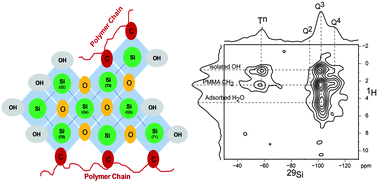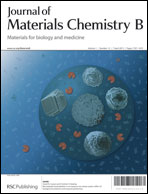Molecular interactions in coupled PMMA–bioglass hybrid networks†
Abstract
Organic–inorganic hybrids were produced by chemical bonding of poly(methyl methacrylate) (PMMA) and bioglass using the silane coupling agent (3-trimethoxysilyl propyl methacrylate (MPMA)). The effects of MPMA : PMMA molar ratio and volume fraction of polymer solution on the characteristics of hybrids were assessed. 1H, 13C and 29Si solid state NMR analyses were used to investigate the structural features at molecular level to better understand the impact of coupling agent on the network structure of hybrids. Tn peaks in 29Si CPMAS NMR spectra were only observed for hybrids and not for physical mixtures, which confirmed the presence of Si–C covalent bonds and formation of class II hybrid. Compared to physical mixture, the number of Q4 species also showed a 20% reduction for the highly coupled hybrid containing 0.1 M ratio of MPMA : PMMA and 60 vol% polymer solution. These analyses elucidate the integration of PMMA chains into bioglass structure in nano-scale. Additionally, presence of peaks at 1030 cm−1 (Si–O–Si) and 1110 cm−1 (Si–O–C) in Fourier transform infrared (FTIR) spectra confirmed the formation of covalent bonds in hybrid components. These results showed molecular interaction between PMMA and silica and shed light on the enhancement of physical properties of hybrids. For instance, thermal gravimetric analysis (TGA) of the hybrid showed significant enhancement in thermal resistivity as compared to the neat PMMA. The composition of PMMA–bioglass hybrids was tuned to provide fast gelation of ca. two hours yielding homogenous and transparent materials with unique thermal stability, functionality and broad applications, particularly as bone implants.


 Please wait while we load your content...
Please wait while we load your content...